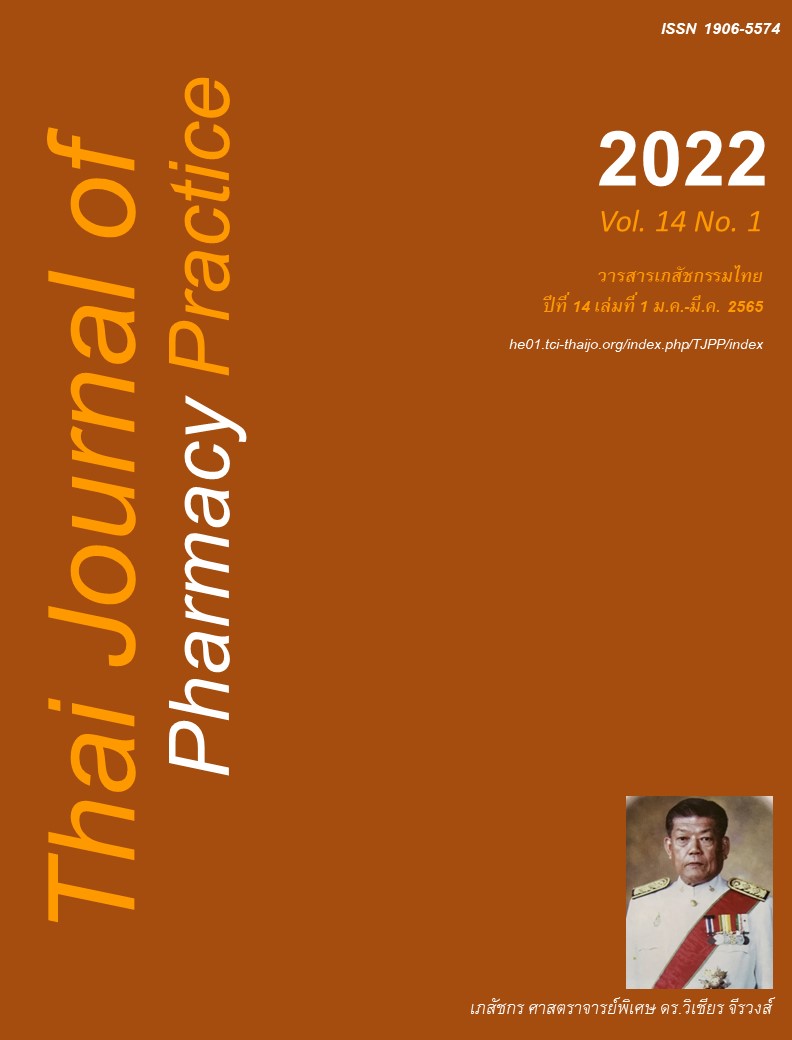ผลลัพธ์ของโปรแกรมการเลิกบุหรี่โดยเภสัชกรในร้านยา: กรณีศึกษาร้านยามหาวิทยาลัยแห่งหนึ่ง
Main Article Content
บทคัดย่อ
วัตถุประสงค์: เพื่อประเมินประสิทธิภาพและความพึงพอใจต่อโปรแกรมการเลิกบุหรี่โดยเภสัชกรในร้านยามหาวิทยาลัย วิธีการ: การศึกษานี้เป็นงานวิจัยเชิงทดลองในผู้รับบริการในร้านยามหาวิทยาลัย ตัวอย่างถูกแบ่งออกเป็น 2 กลุ่ม ได้แก่ กลุ่มที่ได้ยา nortriptyline และกลุ่มที่ได้หมากฝรั่งนิโคติน ซึ่งทั้งสองกลุ่มได้รับคำปรึกษาและติดตามโดยเภสัชกรในร้านยามหาวิทยาลัย การประเมินประสิทธิภาพทำโดยวัดปริมาณคาร์บอนมอนอกไซด์ จำนวนมวนบุหรี่ที่สูบต่อวัน รวมทั้งมีการประเมินอาการไม่พึงประสงค์จากการใช้ยา และความพึงพอใจของผู้รับบริการ ผลการวิจัย: กลุ่มที่ได้รับยา nortriptyline มีจำนวน 12 คน และกลุ่มที่ได้รับหมากฝรั่งนิโคติน มีจำนวน 11 คน พบว่าผู้ที่มีปริมาณคาร์บอนมอนอกไซด์ < 10 ppm เพิ่มขึ้น 5 รายทั้งในกลุ่มที่ได้ยา nortriptyline และในกลุ่มที่ได้หมากฝรั่งนิโคติน (P = 0.855) จำนวนมวนบุหรี่ที่สูบต่อวันในเดือนที่ 3 เทียบกับวันเริ่มการให้บริการในกลุ่ม nortriptyline ลดลง 11.92 ± 7.28 มวนและในกลุ่มหมากฝรั่งนิโคตินลดลง 11.91 ± 4.37 มวน (P = 0.998) อาการไม่พึงประสงค์จากการใช้ยาในกลุ่ม nortriptyline พบในตัวอย่าง 8 ราย และกลุ่มที่ได้รับหมากฝรั่งนิโคตินพบในตัวอย่าง 3 ราย (P = 0.022) ความพึงพอใจต่อโปรแกรมการเลิกบุหรี่ในกลุ่มที่ได้รับยา nortriptyline มีความพึงพอใจในระดับปานกลางถึงมากและในกลุ่มที่ได้รับหมากฝรั่งนิโคตินอยู่ในระดับมากถึงมากที่สุด สรุป: ประสิทธิภาพของโปรแกรมการเลิกบุหรี่โดยเภสัชกรชุมชนของผู้ที่ได้รับยา nortriptyline และหมากฝรั่งนิโคตินไม่แตกต่างกัน
Article Details
ผลการวิจัยและความคิดเห็นที่ปรากฏในบทความถือเป็นความคิดเห็นและอยู่ในความรับผิดชอบของผู้นิพนธ์ มิใช่ความเห็นหรือความรับผิดชอบของกองบรรณาธิการ หรือคณะเภสัชศาสตร์ มหาวิทยาลัยสงขลานครินทร์ ทั้งนี้ไม่รวมความผิดพลาดอันเกิดจากการพิมพ์ บทความที่ได้รับการเผยแพร่โดยวารสารเภสัชกรรมไทยถือเป็นสิทธิ์ของวารสารฯ
เอกสารอ้างอิง
Tongpiw A, Rungruanghiranya S, Suntorntham S. Practice guideline for treatment of tobacco in chronic disease in Thailand. Bangkok: Sintaveekit Printing Limited; 2018.
Connolly MP, Kotsopoulos N, Suthipinijtham P, Rungruanghiranya S. Fiscal impact of smoking cessation in Thailand: A government perspective cost-benefit analysis. Asia Pac J Public Health. 2018; 30: 342-50.
World Health Organization. WHO report on the global tobacco epidemic: 2019. Geneva: World Health Organization; 2019.
Aungkulanon S, Pitayarangsarit S, Bundhamcha roen K, Akaleephan C, Chongsuvivatwong V, Phoncharoen R, et al. Smoking prevalence and attributable deaths in Thailand: predicting outcomes of different tobacco control interven tions. BMC Public Health. 2019; 19: 984.
Owenstein C, Dow WH, White JS. Peer effects in smoking cessation: An instrumental variables analysis of a worksite intervention in Thailand. SSM Popul Health. 2020 ;12: 100659.
Lochid-amnuay S, Kessomboon N, Putthasri W, Puangkantha W. Recommendations on incorporating accredited community pharmacy into universal coverage in Thailand. Thai Journal of Hospital Pharmacy 2011; 21: 189-202
Chinwong S, Chinwong D. A national survey of community pharmacists on smoking cessation services in Thailand. Pharmacy (Basel). 2018; 6: 101.
Kumsook D. Sookaneknun P. Ploylearmsang C. Sangsirirak E. Comparing the effectiveness of nortriptyline and nicotine gum with pharmacist counseling for smoking cessation in nicotine dependence smokers. Isan Journal of Pharmaceu tical Sciences 2014; 10: 372-88.
Wray JM, Gass JC, Miller EI, Wilkins DG, Rollins DE, Tiffany ST. A comparative evaluation of self-report and biological measures of cigarette use in nondaily smokers. Psychol Assess. 2016; 28: 1043-50.
Laugesen M, Epton M, Frampton CM, Glover M, Lea RA. Hand-rolled cigarette smoking patterns compared with factory-made cigarette smoking in New Zealand men. BMC Public Health. 2009; 9: 194.
Bunditakul K, Bunditakul W, Chalongsuk R. Effectiveness of smoking cessation program by the community pharmacist in Bangkok. Thai Bulletin of Pharmaceutical Sciences. 2014; 9: 1-17.
El Hajj MS, Kheir N, Al Mulla AM, Al‐Badriyeh D, Al Kaddour A, Mahfoud ZR, et al. Effectiveness of a pharmacist‐delivered smoking cessation program in the state of Qatar: a randomized controlled trial. BMC Public Health 2017; 17: 215.


